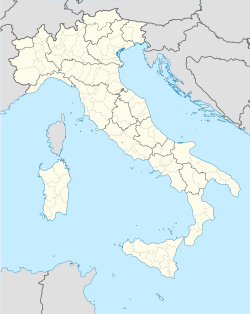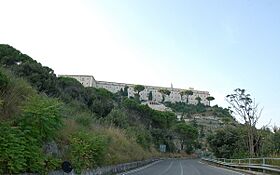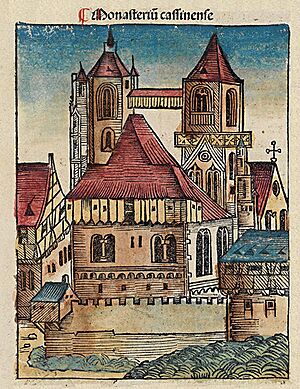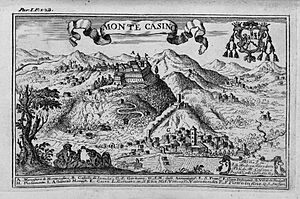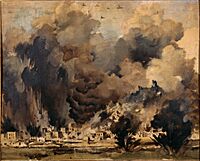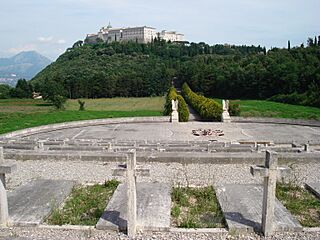Monte Cassino facts for kids

Abbey of Monte Cassino
|
|
| Monastery information | |
|---|---|
| Order | Benedictine |
| Established | AD 529 |
| Diocese | Diocese of Monte Cassino |
| People | |
| Founder(s) | Benedict of Nursia |
| Abbot | Antonio Luca Fallica OSB |
| Site | |
| Location | Cassino, Italy |
| Coordinates | 41°29′24″N 13°48′50″E / 41.49000°N 13.81389°E |
| Public access | Yes |
The Abbey of Monte Cassino (also called Montecassino) is a famous Catholic monastery. It belongs to the Benedictine order of monks. This important abbey sits on a rocky hill about 130 kilometers (80 miles) southeast of Rome, Italy.
It was founded by Benedict of Nursia around the year 529 AD. This makes it the very first home of the Benedictine Order. Saint Benedict also wrote the Rule of Saint Benedict here. This rule became a guide for monks all over Western Europe.
Over its long history, Monte Cassino has been destroyed and rebuilt many times. It was attacked by invaders like the Lombards and Saracens. It also suffered from an earthquake. In World War II, it was almost completely destroyed by bombing. Each time, it was rebuilt, showing its lasting importance.
Contents
A Look at Monte Cassino's History
Early Beginnings
The area around Monte Cassino has a very old history. The Volsci people first built a fort on the hill around 500 BC. Later, the Romans took over and called the settlement Casinum. They built a temple to the god Apollo on the hill.
By the 400s AD, the Roman Empire had become Christian. The town of Cassino became a center for a bishop. However, the area was often attacked by invaders. This caused the town to become abandoned and neglected.
Saint Benedict's Time
Around 530 AD, Benedict of Nursia came to Monte Cassino. At that time, many people in the area still followed old pagan religions. Benedict found a temple to Apollo on the hill. He broke the statue of Apollo and destroyed the altar. He then turned the temple into a chapel dedicated to Saint Martin. He also built another chapel for Saint John the Baptist.
Stories say that Satan tried to stop the monks from building the monastery. For example, a rock became too heavy to move until Benedict prayed. Another time, a wall collapsed on a young monk, but Benedict brought him back to life. These stories show the challenges Benedict faced.
Benedict stayed at Monte Cassino for the rest of his life. He wrote the Rule of Saint Benedict there. This rule set out how monks should live and work. It also said that monks should care for the sick. Because of this, Monte Cassino had one of the first hospitals in Europe. Monks learned about medicine and helped people who were ill or injured.
Archaeologists have found traces of the chapels Benedict built. This confirms parts of the old stories. The first chapel was small, suggesting a small group of monks lived there.
Times of Destruction and Rebuilding
Monte Cassino's location on a high hill made it important for defense. This also meant it was often attacked.
- In 581, the Lombards attacked and destroyed the abbey. The monks had to flee to Rome.
- The abbey was rebuilt in 718 by Abbot Petronax. Important people like Carloman (son of Charles Martel) and Paul the Deacon lived there.
- In 744, the abbey gained control over a large area of land called the Terra Sancti Benedicti. This made the monastery like a small state.
- In 884, Saracen invaders attacked and burned the abbey again. Abbot Bertharius was killed.
The Golden Age of the Abbey
Monte Cassino was rebuilt and became very famous in the 1000s. This was under the leadership of Abbot Desiderius (who later became Pope Victor III). During this time, the abbey's library grew huge. Monks collected and copied many books on medicine and other subjects. They translated important texts from Greek, Roman, and Islamic scholars into Latin.
The monastery became a major center for learning and medicine in Europe. Many doctors came there to study. This led to the creation of the first High Medical School in Europe, located nearby in Salerno.
The abbey buildings were rebuilt in a grand style. Artists from different places, including Constantinople, helped decorate the church. The new church was consecrated (blessed) in 1071 by Pope Alexander II.
Later Challenges
In 1349, an earthquake damaged the abbey. Even though it was rebuilt, this marked the start of a long period of decline. In 1799, French soldiers attacked and looted Monte Cassino during the French Revolutionary Wars.
In 1866, the Italian government closed many monasteries, including Monte Cassino. The building became a national monument. The monks stayed on as caretakers of its treasures.
The Battle of Monte Cassino
During World War II, Monte Cassino became a key battleground. In 1944, the town of Cassino was part of the German "Gustav Line." This was a strong defense line meant to stop Allied troops from moving north towards Rome.
The abbey itself was not initially used by German soldiers. However, Allied commanders believed it was being used as an observation post. On February 15, 1944, the abbey was heavily bombed by American-led air forces. Sadly, no German troops were inside the abbey at the time. Instead, 230 Italian civilians who were seeking safety there were killed. After the bombing, German paratroopers moved into the ruins because they offered good defensive positions. This led to the long and difficult Battle of Monte Cassino.
After the War
After World War II, the Abbey of Monte Cassino was completely rebuilt. The Italian President Luigi Einaudi helped a lot with the rebuilding efforts. Pope Paul VI blessed the rebuilt church on October 24, 1964.
In 2014, Pope Francis made some changes to the abbey's territory. The abbey's spiritual control was reduced to just the monastery itself. The surrounding parishes were transferred to another diocese. As of 2023, Antonio Luca Fallica is the current abbot. The monastic community has 13 monks.
Treasures of the Abbey
Before the bombing in 1944, many valuable items were stored at Monte Cassino for safekeeping. These included about 1,400 old manuscripts and many historical documents. There were also collections from the Keats–Shelley Memorial House in Rome.
German officers helped move these treasures to the Vatican to protect them. However, some accounts suggest that some items, like 15 cases from the Museo di Capodimonte in Naples, might have been taken by German leaders.
Important People Buried Here
Many important people are buried at Monte Cassino Abbey, including:
- Pope Victor III
- Saint Benedict
- Saint Scholastica (Saint Benedict's sister)
- Carloman (mayor of the palace)
- Władysław Anders (a Polish general)
- Members of the Polish 2nd Army Corps who fought in the Battle of Monte Cassino.
See also
 In Spanish: Batalla de Montecassino para niños
In Spanish: Batalla de Montecassino para niños
- Battle of Monte Cassino
- Polish cemetery at Monte Cassino
- Red Poppies on Monte Cassino (a famous song)
- Lamp of Brotherhood, lamps given out at Monte Cassino to encourage peace after World War II


